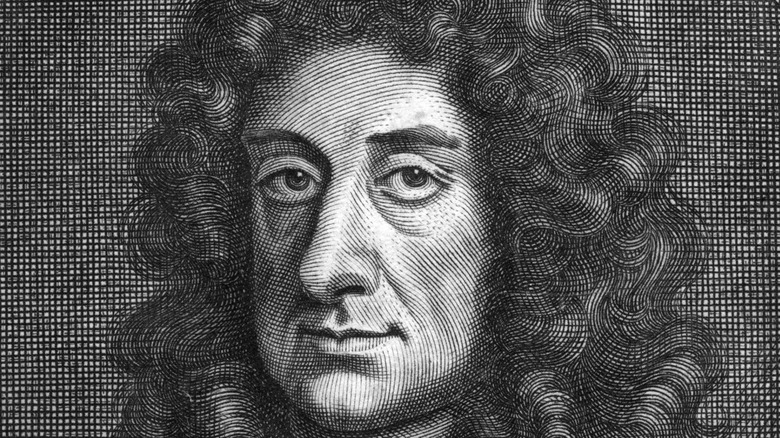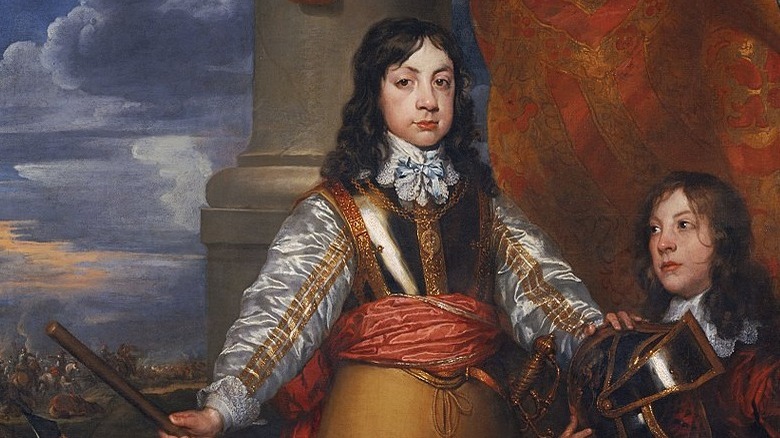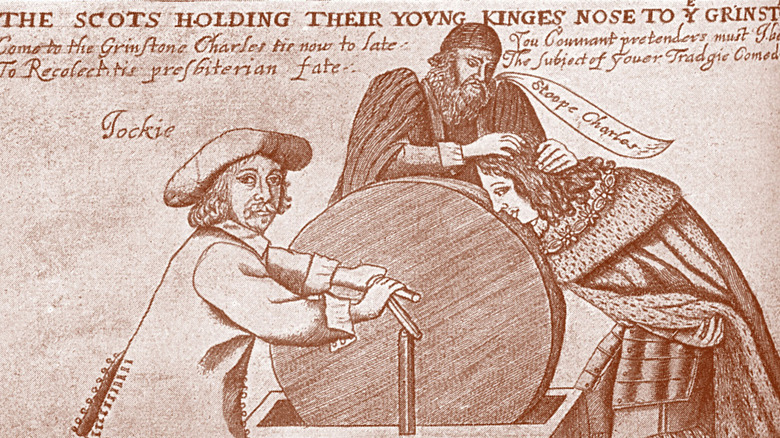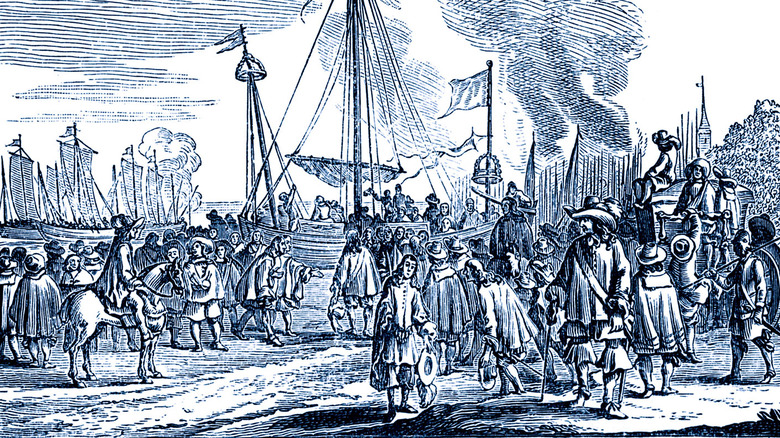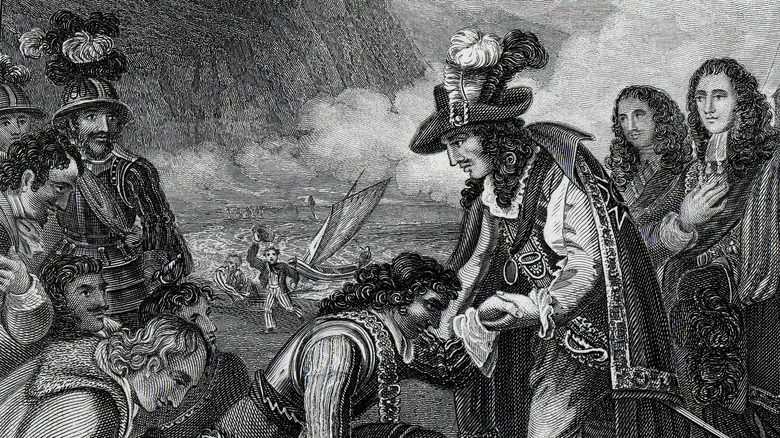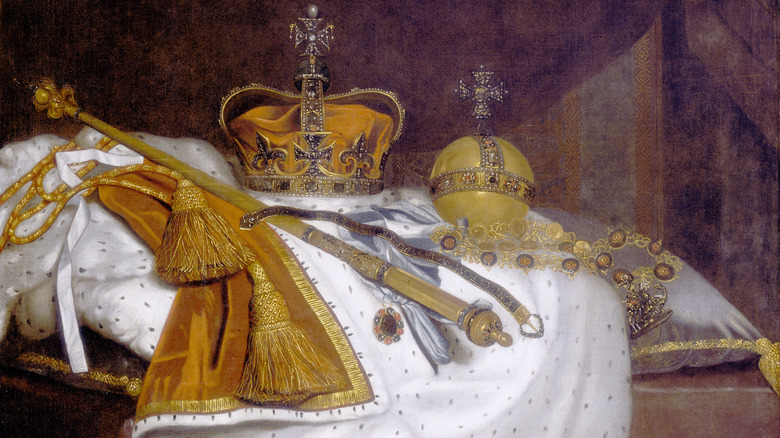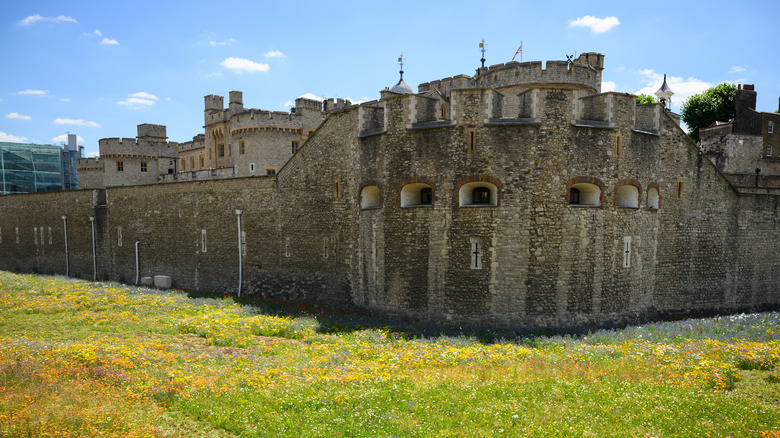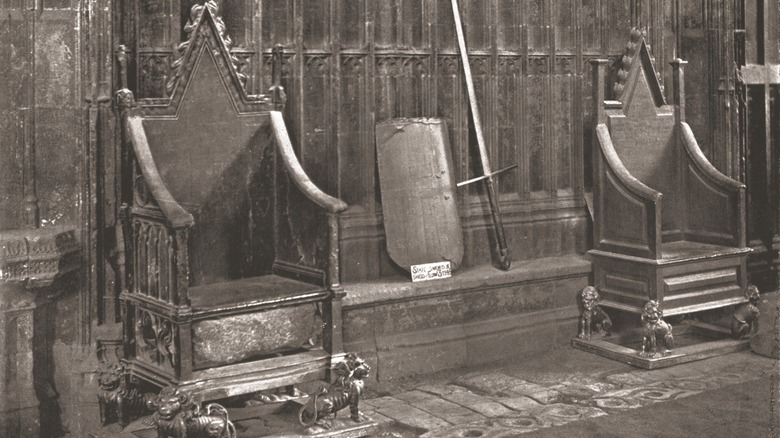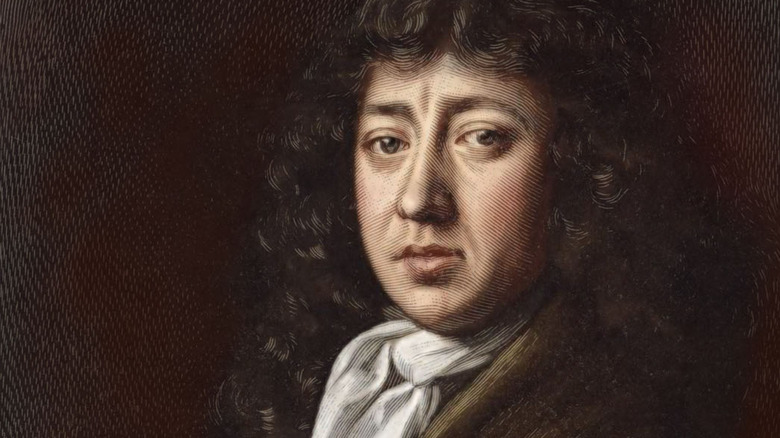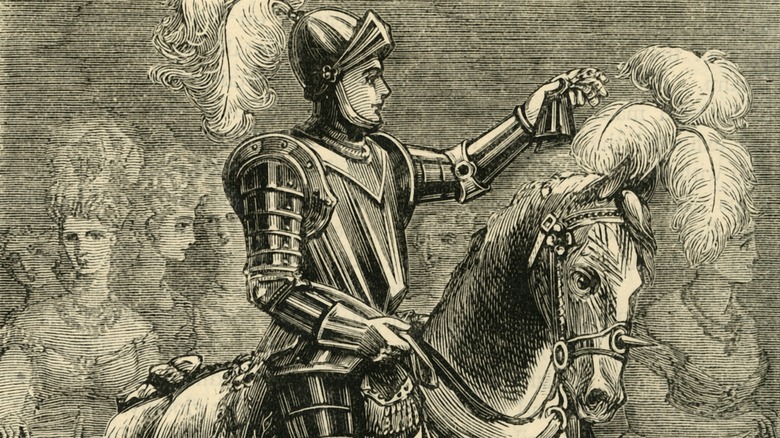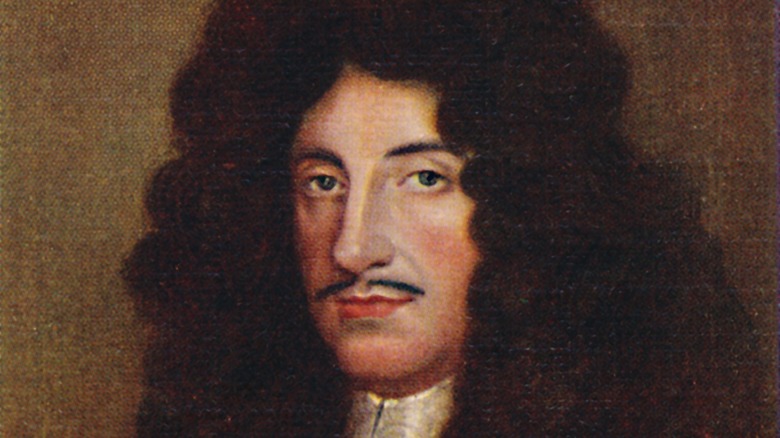The Untold Truth Of Charles II's Coronation
Charles II was England's merry monarch, the hedonistic and waggish antidote to years of instability and puritanism under the Commonwealth. This, at least, is the popular memory. And he was popular in his own lifetime, though his reign wasn't one long party of wits and adultery. Per Britannica, the Stuart Restoration's delights were offset by the Great Fire of London, humiliation in the Anglo-Dutch War, lingering tensions between the religious forces of Catholicism, Anglicanism, and Separatism, and the spendthrift ways of the king.
The Restoration also saw a continuing decline of monarchical power in favor of Parliament, a process Charles himself didn't always passively accept. He had hoped to promote greater religious tolerance, but the House of Commons wouldn't allow it. Nor did the income they guaranteed the king immediately match his expenditures, a fact Charles disregarded with abandon. His foreign policy indebted him to Louis XIV, he fathered plenty of children but no legitimate heirs, and the prospect of his autocratic and Catholic brother James succeeding him nearly lost Charles England.
A canny if skeptical operator in the world of politics, Charles found a settlement with Parliament — at least for the remainder of his lifetime — and posterity remembered his roguish charm more than the blunders and scuffles with a government still transitioning to constitutional monarchy. But for any of it to happen, a crown and a coronation was required — one that might never have happened.
Charles the (almost) uncrowned
Royal life has its charms, as Charles II had good cause to confirm. The oldest son of Charles I of England and Henrietta Maria of France, the younger Charles spent his youth in palaces. Per Richard Lawrene Ollard's "The Image of the King: Charles I and Charles II," his upbringing and education were intended to mold the young prince into the ideal image of a monarch, as understood by his father. Direct interaction with commoners and intimate knowledge of the needs of the kingdom took a backseat to projecting majesty.
Charles II's idle apprenticeship for kinghood faced a rude interruption before he reached his teens. Tensions between Charles I and Parliament over fiscal, religious, and civil matters had made the king deeply unpopular in England (per Britannica), and his handling of Scotland and Ireland set off revolts. The elder Charles was forced to recall Parliament to address these disturbances, but he was unwilling to address the grievances the legislature put before him. Unable to reconcile, the two parties turned on one another, setting off the English Civil Wars in 1642.
Charles II was 12 when the war broke out, according to Historic UK. His youth didn't preclude him from taking command of his father's forces in western England. But the tide of war turned in favor of Parliament within a few years. The young Charles was forced into exile. He attempted to rescue his father, but Charles I was executed in 1649 (per Britannica).
His first coronation was in Scotland
When Charles I was executed in England in 1649, Charles II was safe in exile. The execution of a king for treason in an era where, as Royal Museums Greewich notes, Divine Right was a widely held doctrine, was a disturbing and unprecedented event. It was also, per History Today, deeply unpopular; most of the rebels in the English Civil Wars may have opposed the policies of Charles I, but few wanted the king killed or the monarchy abolished.
Opposition to the emergent English Commonwealth was pitched in Scotland, and they were quick to support Charles II (per the offical website of the British royal family). They came close to not having a crown to offer him, at least in a literal sense; Oliver Cromwell invaded and captured southern Scotland in 1650 and almost made off with the Honours of Scotland. But the jewels escaped his grasp, and a year later, Charles II became the last monarch crowned King of Scots at the ancient coronation site of Scone.
To gain the Scottish throne, Charles II was forced to agree to the National Covenant, a pledge to unite his realms under the Presbyterian faith (per Britannica). It was a choice he grew embittered over in later years, and it did no good in the short term; before the year was out, he was forced to flee back to France.
The Declaration of Breda
After his defeat by Oliver Cromwell's forces in 1651, Charles II spent years in France, without funds or champions for his claim to the throne, according to Britannica. Meanwhile, his former realms were governed by the Commonwealth of England and later the Protectorate dominated by Cromwell. The republican forces never achieved stable government or internal unity, and per History Today, the strict Puritan ideals behind the abolition of the monarchy soon fell out of favor in England.
By the time of Cromwell's death in 1658, tensions between republican zealots and the government, headed by Cromwell's inept son Richard, left the country vulnerable to another civil war. In 1660, a new parliament — known to history as the Convention Parliament — was quick to vote for a restoration of the monarchy, for which there was a healthy appetite among lords and commons alike. Charles II was recalled back to London.
His homeland and his throne weren't returned to him without conditions, however. England wanted its king but not an absolute kingship unencumbered by law or tradition — or by Parliament. Charles would need to make some acknowledgement of their role in government. What he offered, per Godfrey Davies' "Essays on the Later Stuarts," was the Declaration of Breda. In it, Charles expressed a desire for liberty of conscience, general amnesty, honoring payments due the armed forces, and a settlement of land disputes — the details of all to be determined by Parliament.
His coronation was a long time in coming
Technically, a prince in Britain becomes a king by law as soon as his predecessor dies or abdicates, as per the Associated Press (via WTOP). But immediate inheritance has never meant immediate coronation. While a formal proclamation is made as soon as possible after the accession of a new monarch, the coronation is an elaborate ceremony requiring extensive planning, under the supervision of the earl marshal, according to the Guardian. The gap between accession and coronation can be up to a few months or over a year. The one may never follow the other; Edward VIII spent 325 days as king, but he was never crowned (per the British royal family website).
By law, Charles II was king as soon as his father was executed in 1649, and he received a coronation in Scotland in 1651. But it was only in 1660, after the Commonwealth ended, that he was clear to return from exile as king of England, Scotland, and Ireland. Per the British National Archives, Charles came home to London on May 29, his 30th birthday. The city was jubilant to have their monarch back — a monarch with a reputation for enjoying himself — after many years under the puritanism of the republic. But nearly a full year would pass before public joy found expression in state and religious ceremony. Charles II's coronation, according to Westminster Abbey, took place on April 23, 1661.
He needed new regalia
The coronation of a monarch is a solemn ceremony of church and state. Per the British royal family website, many of the rituals of British coronations date back to the Norman Conquest of England in 1066. But a coronation, in its most simple and literal form, is placing a crown on the head of a king or queen. And as Charles II prepared for his coronation in 1661, he was faced with a dilemma: He had no crown, nor any other regalia.
The English regalia prepared for Edward the Confessor became the core of the crown jewels, according to the Royal Collection Trust, and were used in coronations for 400 years. Charles I kept these relics even as he was forced to auction off other treasures of the crown before the English civil wars. But as symbols of royalty, the regalia were scorned by Oliver Cromwell. During the years of the Commonwealth, he had them broken, the gemstones sold, and the gold melted down to mint coins (per the National Archives). Only the coronation spoon survived, notes the Royal Collection Trust.
A new crown, orb, and scepter were needed for Charles II. St. Edward's Crown was recreated, though the Royal Collection Trust notes that it isn't a perfect replica. But with the new regalia came a new wrinkle in the coronation. Traditionally, the royal spurs were worn on the sovereign's feet for the ceremony, but starting with Charles II (per the Royal Collection Trust), they only needed to touch the monarch's ankles.
It was the last coronation with a procession from the Tower of London
The Tower of London has acquired a rather imposing reputation over the years, thanks to its use as a prison and legends of the princes in the Tower, according to English Monarchs. But the Tower also holds the Jewel House, resting place for the regalia and other treasures of the crown. And it used to play a key role in the coronation ceremony.
According to "The Tower of London: The Official Illustrated History," it was tradition from at least 1308 that a monarch would spend the night in the Tower of London before taking part in an elaborate procession to Westminster Abbey. This would date the custom as far back as the reign of Edward II, who was crowned that year, according to Westminster Abbey. Records show Richard II taking place in the procession in 1377.
Charles II was keen to incorporate the procession from the Tower into his coronation, per "The Official Illustrated History," if only to demonstrate the ancient traditions of monarchy enduring despite the brief interruption of the Commonwealth. But by the time of his coronation, the royal apartments in the Tower had deteriorated to an unfit state. Charles was at the gates of the Tower to join the procession on the day of his coronation, but he didn't stay the night, and he was the last monarch to travel from the Tower to the abbey.
Seating was provided for the first time
Watching royal events today is no trouble at all. Be it a coronation, a wedding, a funeral, or a state opening of Parliament, they can all be taken in by anyone in the United Kingdom, or around the world. Physical attendance isn't necessary; the biggest shows are all broadcast on TV or streaming, so you can watch from the comfort of your own home. For those so inclined to attend in person, even braving the often cold and wet weather of the .K., there are designated areas to sit and stand, orderly queues, and helpful signs, barriers, and protocols.
In the 17th century the only way to see something like a royal coronation was in person, and anyone who didn't live in London needed to make the trek there and hope that there was space. To try and improve visibility, monarchs before Charles II had their coronations held on a raised platform specially built for the occasion, according to Westminster Abbey. The throne would be on top, and the sovereign would ascend to take his seat.
Starting with Charles II in 1661, it was the audience that had raised seats. Tiered platforms were put together in the transepts of Westminster, allowing viewers an elevated place to look down on the coronation ceremony. One imagines this contributed to the £12,000 cost of the coronation, over £1.5 million in 2021 money, per the Bank of England inflation calculator.
The coronation was well-documented
The coronation of Charles II is of course notable for marking the restoration of the monarchy after the Commonwealth years. But it's also notable for how well it was covered in ways that survive to this day. The entire ceremony was detailed in not one, but two impressive accounts.
The University of Michigan Library's Eighteenth Century Collection holds the report of Elias Ashmore and Francis Sandford. They broke down the coronation step by step, detailing the titles and names of the participants and in what order they came in the procession, the songs sung and prayers recited, and each step taken and word spoken by the king. Ashmore and Sandford's was a first-hand account; they not only attended, but as heralds, they would have been part of the coronation.
A more distant, and more literary, observation of Charles's crowning came from Samuel Pepys. Pepys was many things in his life; an member of Parliament, a prisoner, a scientist, and a champion of the navy (per Royal Museums Greenwich); but it's as a diarist that he's best known to history. His nine-year diary, begun in 1660, is preserved online, and among its pages is Pepys' experience of the 1661 coronation. The glowing account he gave was perhaps a way of compensating for having supported Parliament during the English Civil Wars. But later that very year, Pepys confided in his diary that he feared the excesses of Charles's court would be a disaster for England.
The king's champion
The account of Charles II's coronation set down in Samuel Pepys's diary mentions a rather spectacular incident during the ceremony. A figure on horseback, in full armor with a spear in hand, came riding into Westminster Hall. A herald raised his voice to say of this warrior: "That if any dare deny Charles Stewart to be lawful King of England, here was a Champion that would fight with him." The champion then rode up to the king's table, throwing down his gauntlet three times on the approach. Charles drank to the champion's health, presented him with a gold cup, and sent him riding off again.
This wasn't an impromptu show of loyalty by a gallant Englishman clinging to medieval chivalry. The King's Champion is part of the pageantry of the coronation, dating back to William the Conqueror, according to Historic U.K. Since a monarch by protocol cannot fight anyone in single combat except another monarch, it was necessary for them to have a champion to answer any challenge to their throne, though there was no expectation of the champion actually fighting anyone at the coronation.
Since Richard II's crowning in 1377, the office has been hereditary in the Dymoke family. The ride into Westminster was done away with in 1838, when Queen Victoria was crowned, and by the time of Elizabeth II' coronation in 1953, the challenge was gone too. The champion's job now is to carry the royal standard during the procession.
Charles II's first coronation haunted his reign
Charles II's second coronation marked the formal beginning of the Stuart Restoration, but his reign would be colored by bitter memories from his first crowning. While Charles was prepared then to accept the Scottish Covenanters' demand that he impose the Presbyterian faith across England, Scotland, and Ireland, he was put off by their hectoring over morality and servitude owed to God (per the British royal family website). While far from the most principled of kings, Charles was inclined to religious tolerance, and bartering that concept away for a doomed attempt to reclaim his realms upset him, according to Britannica. When he did come back to the throne, he left Scotland to the duke of Lauderdale.
Charles was unable to sell even his English subjects on religious tolerance; the House of Commons repeatedly blocked his efforts. But the Convenators became a rebel force over religion in 1666, quickly put down at the Battle of Rulion. The corrupt administration of Lauderdale helped fuel their second uprising in 1679. They were defeated again, this time by an illegitimate son of Charles, as per the royal family website.
Religious tensions followed Charles to the grave. With no legitimate children, his heir was his Catholic brother James, and Charles knew that his subjects — particularly the Presbyterian Scots — were unhappy at the thought of a Catholic on the throne, as per Britannica. His canny maneuvering ensured peace in his lifetime, but after his death (as a converted Catholic), the religious issue would help bring down the House of Stuart.
